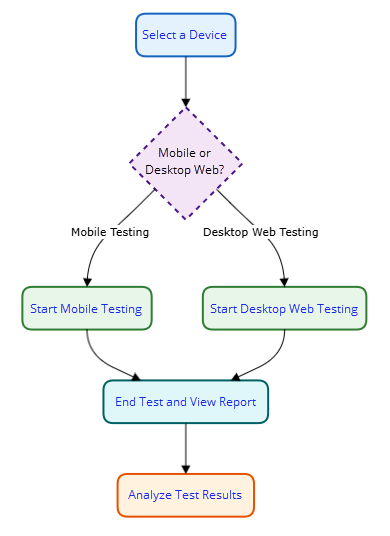Your workflow depends on what your role is and what mobile app types you need to test. Are you a manual tester or an automation engineer? Do you test native apps, hybrid apps, web apps, or progressive web apps (PWA)? The following sections provide details on roles and app types as well as diagrams that illustrate the workflow and let you jump right in.
On this page:
Manual testing vs. automation testing
The biggest difference between manual and automation testing is who executes the test case. In manual testing, the human tester does it. In automation testing, the tool does it, but the automation engineer handles the tool and creates the tests.
Manual testing is the process in which QA analysts execute tests one-by-one in an individual manner. The purpose of manual testing is to catch bugs and feature issues before a software application goes live. The tester validates the key features of a software application. Analysts execute test cases and develop summary error reports without specialized automation tools. That is why manual testing is very hands-on. It requires analysts and QA engineers to be highly involved in everything, from test case creation to actual test execution. Manual testing is slower overall, but it better handles complex scenarios.
Automation testing is the process in which testers utilize tools and scripts to automate testing efforts. It helps testers execute more test cases and improve test coverage. It is usually more efficient than manual testing. Automation testing involves testers writing test scripts that automate test execution. A test script is a set of instructions to be performed on target platforms to validate a feature or expected outcome.
With Scriptless Web and Scriptless Mobile, you can create automation tests even if you don't have a scripting background.
The following table provides an at-a-glance comparison.
|
|
Manual testing |
Automation testing |
|---|---|---|
|
Test execution |
Done manually by QA testers. |
Done automatically using automation tools and scripts. You can also use Scriptless Web and Scriptless Mobileto create tests and schedule them to run at recurring times. |
|
Test efficiency |
More time-consuming, but better at handling complex scenarios. |
Achieves more testing in less time and with greater efficiency. |
|
Types of tasks |
Entirely manual. |
Mostly automated, including real user simulations. |
|
Test coverage |
Difficult to ensure sufficient test coverage. |
Ensures greater test overage. |
|
Summary |
Allows for focused attention. Increases the ability to handle complex and nuanced test scenarios. |
Allows for more testing in less time. Increases productivity and expands how much you can test. |
App types
With Perfecto, you can test any of the application types listed in the following table.
|
App type |
Description |
|---|---|
|
Native (iOS/Android) |
Specific to iOS or Android. An iOS app is built into an IPA binary file that you can test with the Appium and/or XCUITest frameworks. An Android app is built into an APK package that you can test with the Appium and/or Espresso frameworks. |
|
Hybrid |
Includes a native application wrapper that is independent of iOS or Android. This means that a hybrid application can access all operating system specific capabilities. You can install a hybrid app from the Apple App Store or Google Play. These apps are also supported by Appium. |
|
Web |
Pure web apps that you can access through mobile native browsers, such as Google Chrome, Apple Safari, or Mozilla Firefox. These apps are supported by Selenium. |
|
Progressive Web App (PWA) |
An installable web link specific to iOS and Android. Examples are Instagram and Twitter. You can create a shortcut to these apps and install them without going to the Apple App Store or Google Play. |
Perfecto workflow
The following diagrams illustrate the manual testing and automation testing workflows based on your role. The path you take within these flows depends on your app type. If you are an automation engineer, your path also depends on whether you have existing Selenium, Appium, XCUITest, or Espresso tests or plan to create or maintain tests with Perfecto's Scriptless Automation products.
To learn more about a step, click the link in the respective shape inside the diagram.
Manual tester

Automation engineer
